By Setareh Sadeqi*
The United States of America is a unique place in the world, for studying population and demography, thanks to the diversity of the backgrounds of both home-born and foreign-born citizens. According to the official website of the United States’ Census Bureau, one international migrant enters the United States of America every 29 seconds (1), making the country a curious and amazing case, for studying different racial and ethnic backgrounds.
Although the U.S. Congress and House abolished slavery in the 1860s, and even though a hundred years later, after much struggle, an end was put to the notorious Jim Crow Laws--which deprived the blacks, as well as Jews from their basic civil rights and considered them as inferior (2) (3)--there are minority groups in the United States who continue to express grievances about the inequality and discrimination they feel they are facing. (4)
Among these minority groups, the black people of the United States are the ones, whose protesting voice we have heard more often. (5) (6) (7). This, in part, is attributed to the fact that African-Americans, or the Black community of the U.S. has lived there for generations; the first blacks, who stepped foot on American land, were brought to what we know today as the United States of America by force, rather than by choice, and this dates back to more than 400 years ago (8) (9). Therefore, many members of the black community do not know about their background, and do not know any land or any country other than USA. Moreover, not all blacks in America have African origins. (10)
Statistics show that blacks and whites agree, on the fact, that discrimination against blacks in the United States of America is ongoing. According to a survey conducted in March 2013 by the PEW Research Center, 88 percent of black Americans and 57 percent of white Americans believe that there exists some, or a lot of discrimination against blacks in the United States of America (11).
Black or Africa-American?
According to the definition of race categories used in the 2010 Census of the United States, black or African American refers to “a person having origins in any of the Black racial groups of Africa. It includes people who indicated [on the survey forms] their race(s) as “Black, African Am., or Negro” or reported entries such as African American, Kenyan, Nigerian, or Haitian.” (12 p. 3)
On the word of The Office of Management and Budget (OMB), “Black or African American” refers to a person having origins in any of the Black racial groups of Africa. However, the official website adds further explanation when describing the racial category:
“The Black racial category includes people who marked the “Black, African Am., or Negro” checkbox. It also includes respondents who reported entries such as African American; Sub-Saharan African entries, such as Kenyan and Nigerian; and Afro-Caribbean entries, such as Haitian and Jamaican.” (13 p. 2)
Sub-Saharan African entries are classified as Black or African American, with the exception of Sudanese and Cape Verdean because of their complex, historical heritage. North African entries are classified as White, as OMB defines White as a person having origins in any of the original peoples of Europe, the Middle East, or North Africa. (13 p. 2)
It should be noted that the term “black” is becoming more frequently used; according to the Standards for the Classification of Federal Data on Race and Ethnicity offered by The Office of Management and Budget (OMB), “some Blacks who have been in the United States for generations have no record of where in Africa their ancestors were born and do not wish to be called "African-Americans." (14)
Interestingly, when surveyed in 2010, millions of Americans changed their racial category, from what they had previously checked on their survey forms in the year 2000. Non-whites, particularly Hispanics, Americans of mixed race, American Indians and Pacific Islanders were among the groups who were more likely to choose different racial category from one census to another (15). For the same reason, the United States Census Bureau is seeking to make major changes in the way it collects data on ethnicity of its citizens. In other words, the Census Bureau is trying to improve the accuracy and reliability of the data it collects on race and ethnicity of the citizens. (16)
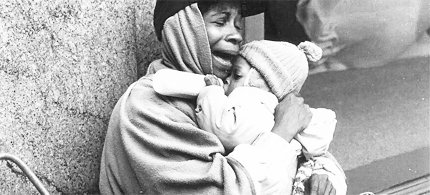
Population
As stated by the Census Bureau of the United States, the population of the United States of America is 322,932,064 (1). In February 2007, the Census Bureau of the United States published a report entitled “The American Community: Blacks 2004” wherein data on the population of the United States was presented by breaking down the numbers into racial and Hispanic origins. Based on this data, the population of black alone in the United States of America was recorded at 34,772,381, making up 12.2 percent of the entire population of the country with a margin error of 0.03. (17)
10 years later, this number witnessed a growth in the number of blacks, either alone or in combination with one or more other races, on July 1, 2014, to 45.7 million, which showed a 1.3 percent rise from the previous year. (18 p. 1)
The same report, composed in 2014 projected the population of the blacks in the United States to grow to 74.5 million by 2060.
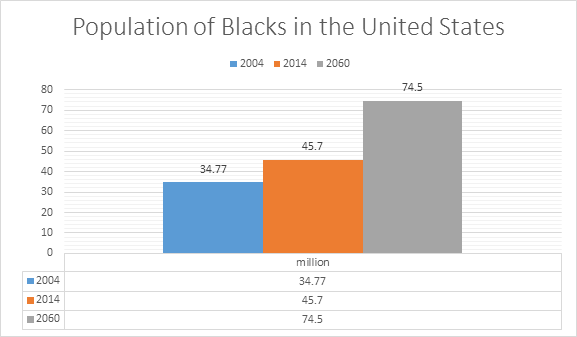
 The number of foreign-born blacks is on the rise, and this is part of what has been projected to add to the total number of blacks by 2060. Based on a PEW Research Center report, in 2013 the number of foreign-born blacks including single-race blacks and mixed-race blacks, regardless of Hispanic origin, was at 3,793,000. The number shows an over 4-time increase from the 1980s, when the foreign-born black population barely reached one million and was at 816,000. (19)
The number of foreign-born blacks is on the rise, and this is part of what has been projected to add to the total number of blacks by 2060. Based on a PEW Research Center report, in 2013 the number of foreign-born blacks including single-race blacks and mixed-race blacks, regardless of Hispanic origin, was at 3,793,000. The number shows an over 4-time increase from the 1980s, when the foreign-born black population barely reached one million and was at 816,000. (19)

Distribution across the United States
Official reports by the government of the United States show that the African-American community, otherwise known as blacks living in the United States of America, have preferred to live in southern states. The 2010 Census report states that of all respondents who reported Black alone-or-in-combination, 55 percent lived in the South, 18 percent in the Midwest, 17 percent in the Northeast, and 10 percent in the West. This pattern was similar for the Black alone population. (13 p. 7)
Based on this report, 55 percent of Blacks or African Americans, alone or in combination, lived in the south in 2010, slightly more than that of the year 2000, when 53.6 percent of the black or African Americans, alone or in combination, lived in southern states of the USA.

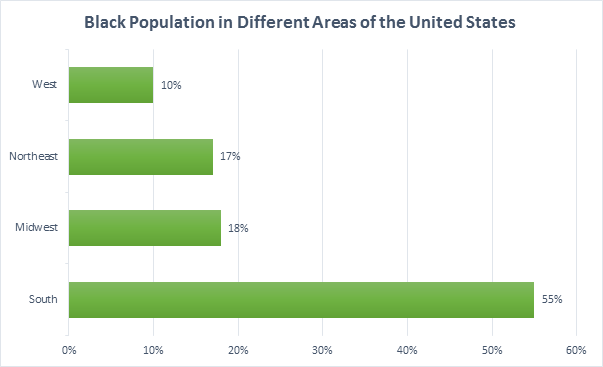
Unemployment Rates: Black vs. White
In February 2015, the U.S. Bureau of Labor Statistics published a report, wherein unemployment rates in the United States were addressed. According to the report, the unemployment rate for African-Americans was 10.4 percent, while the comparable rates for whites, Hispanics, and Asians were 4.7 percent, 6.6 percent, and 4.0 percent, respectively. This is while the national unemployment rate was 5.5 percent. (20) (21) Thus, unemployment rate among blacks in the United States was almost twice as much than the national unemployment rate.
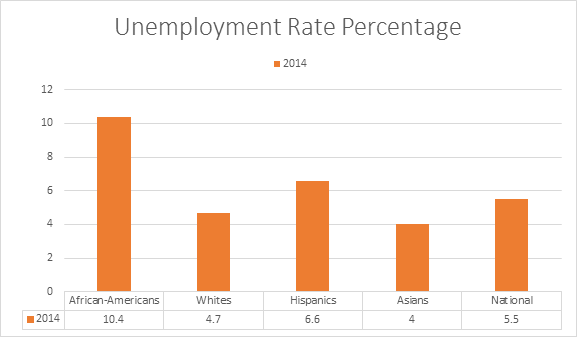
 It should be noted, that fewer job opportunities for members of the black community, in the United States, should not be attributed to lower education. In fact, the above mentioned report also indicates that in 2014, 23.7 percent of unemployed blacks in the United States had attended some college, out of whom, a 15.4 percent had bachelor’s degrees and 4.5 percent had advanced degrees.
It should be noted, that fewer job opportunities for members of the black community, in the United States, should not be attributed to lower education. In fact, the above mentioned report also indicates that in 2014, 23.7 percent of unemployed blacks in the United States had attended some college, out of whom, a 15.4 percent had bachelor’s degrees and 4.5 percent had advanced degrees.
A 2014 study by the Young Invincibles, a nonpartisan education and economic opportunity advocacy group, revealed that an African-American college graduate has the same job prospects as a white high-school dropout, or a white person with a prison record. The study attributed the gap to racial discrimination. (21)
The chart below depicts the unemployment rate difference between black Americans and the total national unemployment changes, from the year 1972 until 2009, as offered by the U.S. Bureau of Labor Statistics, available on the official website. The graph shows that, although for some time black unemployment decreased, the rate has always been much higher than that of other races, or the national unemployment rate.
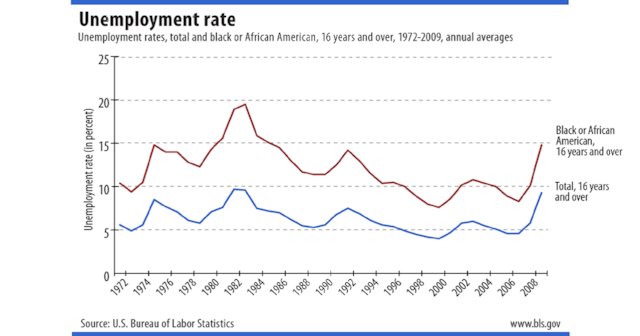
Arguably, high rates of unemployment in the black community have implications for a few other social problems, including violence and poverty, which will be addressed in the following sections.
Poverty and Income
According to the 2012 U.S. Census Bureau American Community Survey, the poverty rate for black Americans in the year 2012 was 28.1%, while this number was at 25.5% seven years before that, in 2005. The increase in poverty rate among African-Americans, otherwise known as blacks, between 2005 and 2012 was observed in every demographic of African Americans, except those aged 65 and over, since they experienced a decrease from 21.2% to 19%. The highest rate of poverty was reported for Black families with children under 18, headed by a single mother. Reportedly 47.5% of single-mother families lived in poverty, while this number was at only 8.4 percent for married-couple Black families. (23)
On the word of the American Community Service briefs, for the years 2007–2011, 42.7 million people that make up 14.3 percent of the U.S. population income are below the poverty level. (24 p. 2)
The same report provides data on poverty by breaking down numbers by race. Accordingly, the highest national poverty rates were recorded for the Natives of America and Alaskan Natives, with a 27.0 percent poverty rate and second came the Blacks or African Americans which recorded a 25.8 percent poverty. (24 p. 2)
On account of the data collected by the U.S. Census Bureau, which presents annual estimates of median household income and poverty by state, race, sex and other smaller geographic units based on data collected in the American Community Survey (aka ACS), median household income was $53,657 in 2014. The number does not show a statistically significant difference, in real terms, from the data reported in 2013 on median household income which was recorded at $54,462. (25 p. 5)
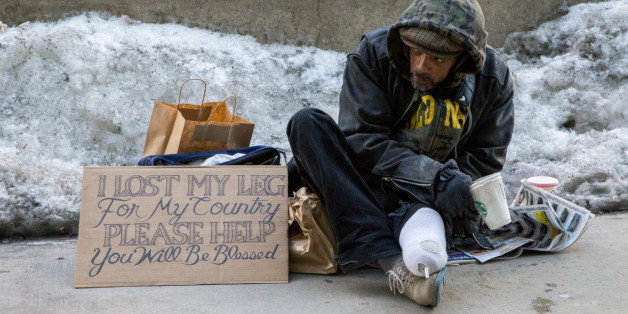
The real average income of non-Hispanic, White households experienced a slight decline of 1.7 percent between the years 2013 and 2014, dropping from $61,317 down to $60,256. For Black, Asian, and Hispanic-origin households, however, the 2013-2014 changes in real average household income were insignificant, and thus overlooked in the report. (25)
As for the median income of the race groups, the highest was recorded for Asian households with an average income of $74,297 in the year 2014. The median income of non-Hispanic White households was $60,256, while for Hispanic households, the median income was $42,491. Blacks or African Americans, once again, recorded the lowest earning, and their median income was recorded the lowest of all races, with $35,398 for the same year.
The official website of the United States Department of Labor, the Bureau of Labor Statistics published a report on “median usual weekly earnings of full-time wage and salary workers by age, race, Hispanic or Latino ethnicity, and sex, fourth quarter 2015 averages, not seasonally adjusted” for the fourth quarter of the year 2015. The report, which was last modified on January 22, 2016, reveals that Asians had the highest average weekly income in the last quarter of the year 2015, and earned $1178 on average, while Hispanic and Latino men, and women in America, recorded the lowest weekly income by earning $624 on average. Blacks or African Americans earned slightly more than Hispanic and Latinos, and recorded a median weekly earnings of $643. Black or African American men, however, earn even lower than Hispanic or Latinos, and record the lowest median weekly earnings of full-time wage and salary workers, among men of all races, by making $674 per week. (26)
The following chart sums up the aforementioned data on median weekly earnings of American citizens based on race and sex. The high rate of unemployment, higher poverty levels, as well as low incomes among Blacks or African Americans work collaboratively to exacerbate the situation of many Black Americans, who are already suffering from a discriminative establishment.

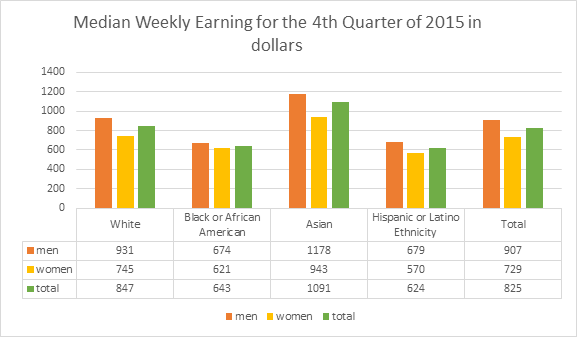
Incarceration
The United States has the highest rate of incarceration, and is the largest imprisoner of the world, holding 20 percent of the world’s prison population, while the country’s population makes up only 5 percent of the world’s total population. Not only is the U.S.’s world population the largest in the world, the country has witnessed an enormous growth in its inmate population over the past thirty years. According to The Sentencing Project the prison population of the United States was recorded at 2.2 million in the year 2013, which shows a 500% increase over the past thirty years. (27)
The statistics show a 500% increase in U.S. prison population, while the U.S. population has just increased by 45%. Behind the scenes of the U.S. prison industrial complex you can find:

US police arrest a female Black Lives Matter activist in Baton Rouge, Louisiana. Photos: Jonathan Bachman/Reuters
“the political and economic interests of America’s elite: Laws; zealous prosecutors; the legislative, judicial, and executive branches at the local, state, and federal levels; the media; transnational corporations; schools; the church; the police; virtually every American institution; and the ideologies and rhetoric of racism, fear, and crime and punishment all work together to maintain the world’s largest prison system.” (28)
The following chart provided by The Sentencing Project, based on data from the Bureau of Justice, shows the rapid growth in incarceration rates in the United States from 1925 till 2013. The chart does not consider the imprisonment rate at private prisons in the United States of America, a rate which is itself a unique one all across the globe.

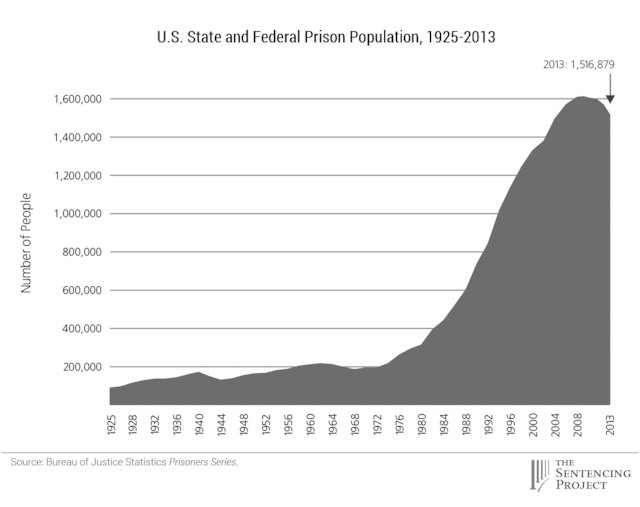
One might contend that this hefty population of imprisoned people is, mainly, because they are real criminals, who deserve to be kept in prisons; this is not the case. The number of inmates kept behind bars continues to rise tremendously, while the crime rate reveals a downward trend. Despite the fact that violent crime has declined in the U.S. (29), incarceration rate has tripled since 1980 (30). About 13 million people are brought to American jails, in any given year. It is totally absurd to mention that more than six million people are under "correctional supervision" in the U.S. These statistics are surprising, as one in fifty Americans have experienced prison sometime in their life, either as inmates, or while on parole, or probation. Currently, 1 out of every 100 Americans is being imprisoned. (31)
One of the most significant implications mass incarceration has for the American society is that a large number of children will grow up in families where fathers are absent, and thus chances of poverty, low educational competences, higher rates of violence and drug abuse- among many other issues--are much stronger.
Drug Policy Alliance published a report in June 2015 where the institute has raised concern over mass incarceration in America, and the discriminate rates of imprisonment which has largely targeted people of color in the United States. According to the report, 2.7 million children are growing up in U.S. households where at least one parent is incarcerated. (32 p. 2)
This is while on the word of the same report, two thirds of these parents are jailed for nonviolent offenses. The situation is even worse for Black or African American children. Reportedly, one in nine Black children has an incarcerated parent, while this numbers stands at one in 28 children for Latinos (aka Hispanics) and one in 57 for white children. (32 p. 2)
The fact that a major proportion of these parents were jailed for nonviolent offenses has one significant implication that the article has been trying to shed light on and that is: racial discrimination in the American judicial system.
The rate of black incarcerations continued to record higher than all other races in the year 2014. The Bureau of Justice of the United States published a report in September 2015 wherein it provides data on incarceration in the United States. On the section where the incarceration rate of the country is broke down by race, the data shows that of all black male residents, 2.7% were serving at least 1 year in prison. Although the black community is experiencing the highest rate of incarceration, the situation is not far better for Hispanic males. According to the U.S. Bureau of Justice, 1.1% of Hispanic males (were serving sentences of at least 1 year in prison when the data was collected in 2014. This is while the rate of incarceration for White American males was less than 0.5%. (33 p. 15)
The report further adds that, according to the data collected on December 31, 2014, black males had higher imprisonment rates than prisoners of other races or Hispanic origin within every age group. The rate at which black males were incarcerated was 3.8 to 10.5 times greater at each age group than that of the white males and 1.4 to 3.1 times greater than rates for Hispanic males.
What exacerbates the situation for the black community and could have stern implications for black or African Americans, is that the largest disparity happens for black men imprisoned as young as 18 or 19. In fact, 1,072 per 100,000 black male residents aged 18 to 19 were imprisoned, which means black or African American males at this age are over 10 times more likely to be in state or federal prison than whites. White Americans aged 18 or 19 were imprisoned at the rate of 102 per 100,000. (33 p. 15)

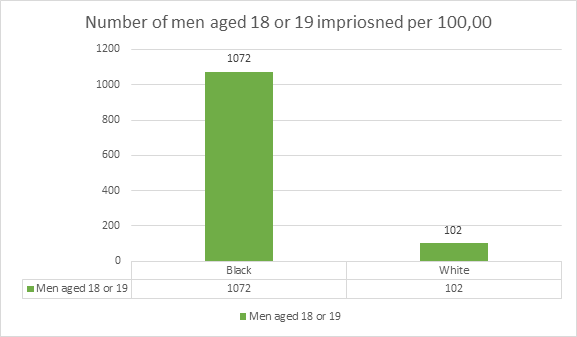
The mass incarceration of young black males has stern long-term results and affects employment rate, percentage of families headed by single mothers, black on black violence, educational competences, etc.
The highest total imprisonment rates by race and Hispanic origin were recorded for males ages 30 to 34. According to the abovementioned report, 6,412 per 100,000 black males, 2,457 per 100,000 Hispanic males, and 1,111 per 100,000 white males were serving in prison in December 2014.
More than 1% of white male Americans aged 30 to 39 were in state or federal prison at by the end of the year 2014. Black males of the same age group surpassed 6% of their total U.S. population in prison.
Moreover, a significant disparity also existed between the incarceration rate for black women than for women of other races. Women ages 30 to 34 had the highest incarceration rates among blacks or African Americans with 264 per 100,000 black females of the same age in prison. This is while white women of the same age recorded 163 per 100,000, and Hispanic females were imprisoned at a rate of 174 per 100,000. Hence, Black females were between 1.6 and 4.1 times more likely to be imprisoned than white females of any age group. (33)

Mortality Rates
- Adolescents and teenage mortality
AstraZeneca Fact Sheet 2011 published by Department of Population, Family and Reproductive Health, and Johns Hopkins Bloomberg School of Public Health indicated that according to U.S. Census Bureau, in the years 2002 and 2003, the teen death rate among Native American and Black teenagers in the United States displayed drastic differences with that of teenagers from other races with American Indian/Alaska Natives making up 91 percent and Black Americans comprising 82 percent of teenage deaths in the United States in those years. (34)
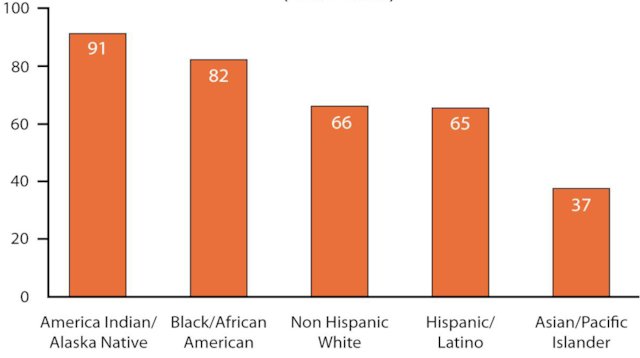
One compelling explanation for higher mortality rates for African Americans is lower access to health facilities.
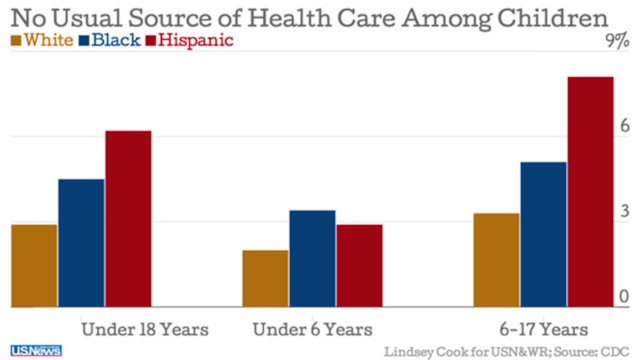
B. Infant Mortality
The infant mortality rate for the United States has remained somewhere around 6, for 4 consecutive years, from 2011 to 2015, based on data provided by the World Bank official website. (35)
Preterm-related deaths are a type of infant mortality where the infant is born preterm, which is before 37 completed weeks of gestation. According to data provided by the Center for Disease Control and Prevention, as of the year 2004, nearly one-half or in other words 46 percent of infant deaths to non-Hispanic black women, and 41 percent of infant deaths to Puerto Rican women were due to preterm-related causes of death, whereas the percentage was to a certain degree lower for other race and ethnic groups. (36)

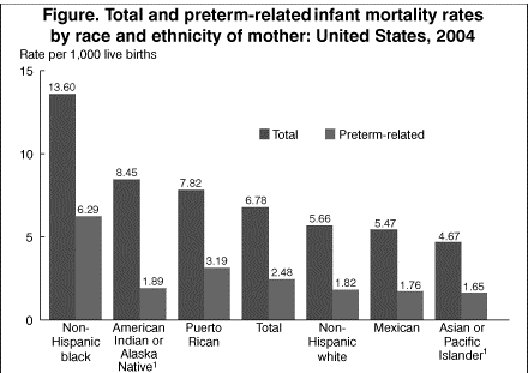
The Infant Mortality Rate or IMR is generally considered as a good indicator of the overall health of a nation’s population. In 2012, a total of 23,629 deaths occurred in children under age 1 year in the United States, showing a decline compared to the previous year. In 2012 there were 356 fewer infant deaths than in 2011. IMR decreased 1.5% from 606.7 infant deaths per 100,000 live births in 2011 to 597.8 in 2012. (37 p. 2)
According to the same report, the 10 leading causes of infant mortality in the United States of America in the year 2012 accounted for 69.8% of all infant deaths in the States. IMR for Sudden infant death syndrome (SIDS), however, experienced a decline of about 12.0%, decreasing from 48.3 infant deaths per 100,000 live births in 2011 to 42.5 in 2012. Mortality rates for the remaining leading causes of infant death do not show a significant change.
In the year 2014, more than 23,000 infants died in the United States. The U.S. Centers for Disease Control and Prevention describes loss of a baby as “a sad reality for many families” which “takes a serious toll on the health and well-being of families, as well as the nation.” (38)
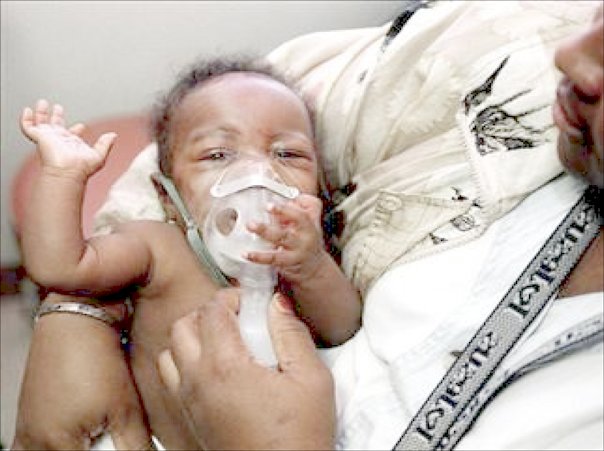
Thus, high infant mortality rate among African Americans implies that black mothers are not provided with, or rarely have access to equal health facilities; thus, they lose their babies at a much higher rate than that of whites. This could also be due to higher rates of poverty among African Americans, which entails lower access to health facilities. Moreover, as the official website of the U.S. Centers for Disease Control and Prevention states, higher rates of infant mortality takes toll on the well-being of families--and since many of the families in the black community already suffer from social problems including poverty that exacerbates the living conditions for black families.
As said by the U.S. Centers for Disease Control and Prevention, while the infant mortality rate for white America is 5.2 infants out of 1,000 births dying before age 1, the infant mortality rate for black America is much higher – 11.5 per 1,000. (39)

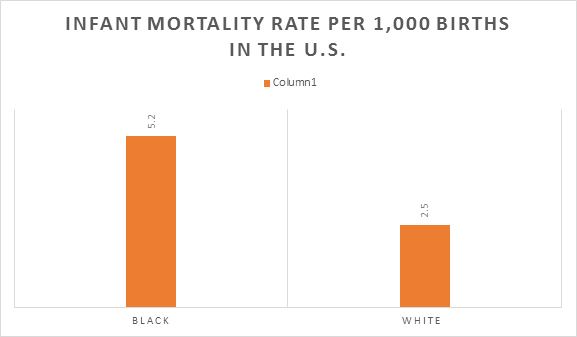
C. Maternal Mortality
In the year 2013 the Maternal Mortality Rate or MMR in the United States of America increased to 18.5 women for every 100,000 births, including women who died within 42 days of childbirth. (40)
This is mainly because American women are placed in poorer health conditions when they become pregnant, and do not receive proper care. The increase in maternal mortality rate is a result of cardiovascular conditions and other chronic health conditions, including obesity, hypertension, diabetes, and heart disease, which are very common among American pregnant women, and these chronic problems have been on the rise. (40)
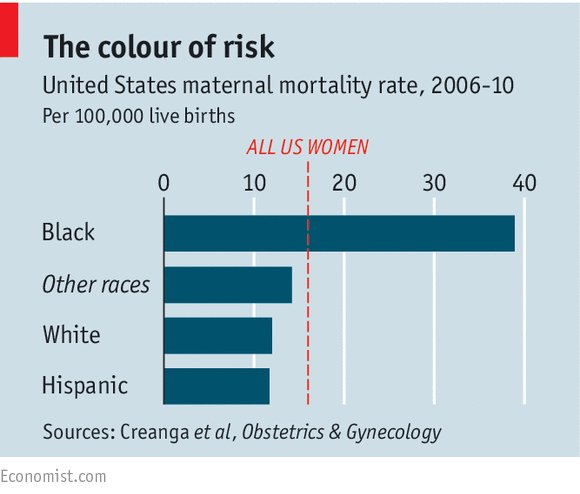

These problematic health conditions are more frequent within the African-American community and for black women. In fact, 40% of black women are obese, compared with 22% of whites. (40)
A study carried out, in multiple states in the U.S., found that eight percent of African-Americans live in a tract with a supermarket, while this number is 31 percent for white Americans. Another study conducted, nationwide, revealed that there are 418 rural “food desert” counties in the United States, residents live more than 10 miles away from a supermarket or supercenter. Only eight percent of Black Americans live in a community with one or more grocery stores, compared to 31 percent of white Americans (41).
Lower access to supermarket and grocery stores, and thus healthy food, partly explains the high rates of obesity and health issues among African-American women, which lead to higher rates of maternal mortality rates among the black community in the United States of America.
Moreover the higher rate of poverty among African-Americans, limited access to health care, and higher rates of unexpected pregnancies may explain why they are approximately four times more likely to die from pregnancy-related complications than white women.
Life Expectancy
The gap between black life expectancy and white expectancy in the United States of America was once called “embarrassing” by Lauren Friedman of Business Insider.
He reported in 2014 that the latest analysis by the Centers for Disease Control (CDC) show that the average life expectancy for Americans in 2009 was 79 years, experiencing an increase from 68 in 1950 and 57 in 1929. (42)
However, there exists a major gap between black life expectancy and white expectancy in the United States.

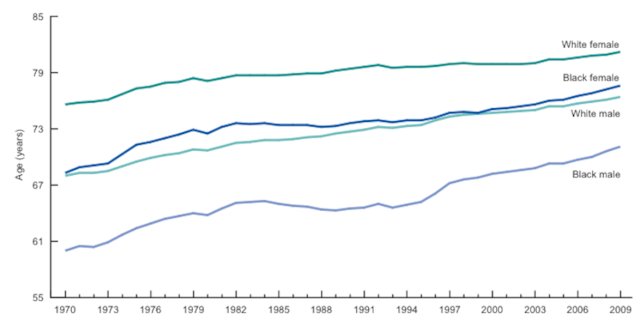
When an end was put to the slavery and when, later on, the Jim Crow laws were abandoned, the black community developed aspirations for justice, freedom and equality; however, it did not take them long to realize that things have not changed for them drastically.
Statistics, provided by governmental research bodies, reveal that people of color are still struggling for their basic rights. The most basic civil services are not available to the African American community, and black Americans continue to deal with more social justice issues than their white fellows.
While many blame blacks, for all the problems and trouble they have to deal with on a daily basis in the United States, official statistics and demographic information on the black American exposes racial and ethnic disparities, and thus explain black suffering.
References
1. U.S. and World Population Clock. United States Census Bureau. [Online] February 01, 2016. https://www.census.gov/popclock/.
2. Seperate is not Equal. Smithsonian National Musuem of American History. [Online] 2015. http://americanhistory.si.edu/brown/history/1-segregated/jim-crow.html.
3. Jim Crow Laws. National Park Service . [Online] 2015. http://www.nps.gov/malu/learn/education/jim_crow_laws.htm.
4. Cole, Juan. Race inequality between US Whites and African-Americans by the Numbers (Again). Informed Comment. [Online] November 26, 2014. http://www.juancole.com/2014/11/inequality-americans-numbers.html.
5. SELMA, M.S.L.J. |. Black America Still Marching. The Economist. [Online] March 9, 2015. http://www.economist.com/blogs/democracyinamerica/2015/03/black-america.
6. Perez, Evan. Justice report finds systematic discrimination against African-Americans in Ferguson. CNN. [Online] March 4, 2015. http://edition.cnn.com/2015/03/03/politics/justice-report-ferguson-discrimination/.
7. Ilo, Stan Chu. Being a Black Male in America: Racism and the Police. The Huffington Post. [Online] June 10, 2015. http://www.huffingtonpost.com/stan-chu-ilo/being-a-black-male-in-ame_b_7035468.html.
8. Draper, Sharon. TIMELINE OF SLAVERY IN AMERICA 1501-1865. Sharon Draper. [Online] 2015. https://sharondraper.com/timeline.pdf.
9. Rein, Lisa. Mystery of Va.'s First Slaves Is Unlocked 400 Years Later. Washington Post. [Online] September 3, 2006. http://www.washingtonpost.com/wp-dyn/content/article/2006/09/02/AR2006090201097.html.
10. Livingston, Mary M. , Pierce, Latoya and Gollop-Brown, Lou’uan . Not All Blacks Are African American: The Importance of Viewing Advisees as Individuals in a Culturally Mosaic Context. The Mentor. [Online] August 15, 2013. https://dus.psu.edu/mentor/2013/08/blacks-advisees-culturally-mosaic-context/.
11. Doherty, Carroll. For African Americans, discrimination is not dead. PEW Redearch Center. [Online] June 28, 2013. http://www.pewresearch.org/fact-tank/2013/06/28/for-african-americans-discrimination-is-not-dead/.
12. Jones, Nicholas A. , Humes, Karen R. and Ramirez, Roberto R. Overview of Race and Hispanic Origin: 2010. Washington DC : United States Census Bureau, 2010.
13. Rastogi, Sonya, et al., et al. The Black Population: 2010. Washington DC : U.S. CENSUS BUREAU, 2011.
14. Standards for the Classification of Federal Data on Race and Ethnicity. The White House. [Online] August 28, 1995. https://www.whitehouse.gov/omb/fedreg_race-ethnicity/.
15. COHN, D’VERA. Millions of Americans changed their racial or ethnic identity from one census to the next. PEW Research Center. [Online] May 5, 2014. http://www.pewresearch.org/fact-tank/2014/05/05/millions-of-americans-changed-their-racial-or-ethnic-identity-from-one-census-to-the-next/.
16. Cohn, D’Vera and Krogstad, Jens Manuel . U.S. Census looking at big changes in how it asks about race and ethnicity. PEW Research Center. [Online] March 14, 2014. http://www.pewresearch.org/fact-tank/2014/03/14/u-s-census-looking-at-big-changes-in-how-it-asks-about-race-and-ethnicity/.
17. staff of the Pew Hispanic Center. The American Community—Blacks: 2004. Washington D.C. : U.S. Census Bureau, 2007.
18. Black (African-American) History Month: February 2016. Washington DC : Census Bureau, 2016.
19. Anderson, Monica, Lopez, Mark Hugo and Rohal, Molly . A Rising Share of U.S. Black Population is Foreign Born. Washington D.C. : PEW Research Center, 2015.
20. Morrison, Aaron. Black Unemployment Rate 2015: In Better Economy, African-Americans See Minimal Gains. International Business Times. [Online] August 03, 2015. http://www.ibtimes.com/black-unemployment-rate-2015-better-economy-african-americans-see-minimal-gains-1837870.
21. Wilson, Valerie. Black unemployment is significantly higher than white unemployment regardless of educational attainment. Economy Ploicy Institute. [Online] December 15, 2015. http://www.epi.org/publication/black-unemployment-educational-attainment/.
22. African American History Month. Washington DC : U.S. BUREAU OF LABOR STATISTICS, 2010.
23. Poverty. Black Demographics. [Online] 2015. http://blackdemographics.com/households/poverty/.
24. Macartney, Suzanne, Bishaw, Alemayehu and Fontenot, Kayla . Poverty Rates for Selected Detailed Race and Hispanic Groups by State and Place: 2007–2011. Washington D.C. : U.S. Department of Commerce, Economics and Statistics Administration, Census Bureau, 2013.
25. DeNavas-Walt , Carmen and D. Proctor, Bernadette . Income and Poverty in the United States: 2014. Washington D.C. : U.S. Census Bureau, 2015.
26. Economic News Release. Bureau of Labor Statistics. [Online] January 22, 2106. http://www.bls.gov/news.release/wkyeng.t03.htm.
27. Incarceration. The Sentencing Project. [Online] 2104. http://www.sentencingproject.org/template/page.cfm?id=107.
28. Leonard, David J. After Artest: The NBA and the Assault on Blackness. s.l. : SUNY Press, 2012. Available at:https://books.google.com/books?id=-hegS07ek-AC&pg=PA114&lpg.
29. Markon, Jerry. Violent crime in U.S. on the decline. The Washington Post. [Online] 05 25, 2010. [Cited: 02 06, 2016.] http://www.washingtonpost.com/wp-dyn/content/article/2010/05/24/AR2010052402210.html.
30. Gopnik, Adam. The Caging of America: Why do we lock up so many people? The New Yorker. [Online] 01 30, 2012. [Cited: 02 06, 2016.] http://www.newyorker.com/magazine/2012/01/30/the-caging-of-america.
31. Ridgeway, James. Locking Up Profits. readersupportednews. [Online] 11 11, 2011. [Cited: 02 06, 2016.] http://readersupportednews.org/opinion2/279-82/8632-locking-up-profits.
32. The Drug, Mass Incarceration and Race. New York City : Drug Policy Alliance, 2015.
33. Carson, E. Ann. Prisoners in 2014. Washington D.C. : U.S. Department of Justice, 2015.
34. Blum, Robert Wm. and Qureshi, Farah . Morbidity and Mortality among Adolescents and Young Adults in the United States. Baltimore : Johns Hopkins Bloomberg School of Public Health, 2011.
35. Mortality rate, infant (per 1,000 live births). The World Bank. [Online] 2016. http://data.worldbank.org/indicator/SP.DYN.IMRT.IN.
36. MacDorman, Marian F. , et al., et al. Trends in Preterm-Related Infant Mortality by Race and Ethnicity: United States, 1999-2004. Atlanta : U.S. Centers for DIsease Control and Prevention, 2010.
37. Jiaquan , Xu, et al., et al. Mortality in the United States, 2012. Hyattsville : National Center for Health Statistics, 2014.
38. Infant Mortality. Centers for Disease Control and Prevention. [Online] January 12, 2016. http://www.cdc.gov/reproductivehealth/maternalinfanthealth/infantmortality.htm.
39. Cook, Lindsey. Why Black Americans Die Younger. US News. [Online] January 5, 2015. http://www.usnews.com/news/blogs/data-mine/2015/01/05/black-americans-have-fewer-years-to-live-heres-why.
40. Exceptionally deadly. The Economist. [Online] July 18, 2015. http://www.economist.com/news/united-states/21657819-death-childbirth-unusually-common-america-exceptionally-deadly.
41. Treuhaft, Sarah and Karpyn, Allison . The Grocery Gap. Oakland : Policy Link, 2010.
42. Friedman, Lauren. This Chart Showing The Gap Between Black And White Life Expectancy Should Be A National Embarrassment. Business Insider. [Online] January 10, 2014. http://www.businessinsider.sg/huge-racial-gap-in-life-expectancy-2014-1/?r=US&IR=T#.VrjzQrJ97IU.
*Setareh Sadeqi is a PhD student in American Studies at the Faculty of World Studies, University of Tehran. She is a freelance journalist, researcher and translator based in Iran.
The views, opinions and positions expressed on Op-Ed are those of the author(s) and do not necessarily reflect the views, opinions or positions of Khamenei.ir .








